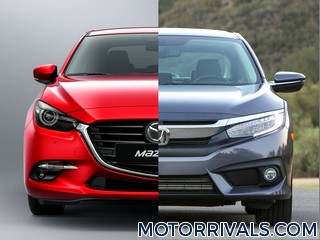2017 Mazda 6 vs 2017 Hyundai Sonata
Mazda Press Release Highlights
Powertrain
The Mazda 6 comes with a choice of two SKYACTIV-D 2.2-litre diesels (150PS & 175PS) and three petrol engines: the SKYACTIV-G 2.0 with 145PS or 165PS, and the 192PS SKYACTIV-G 2.5. Featuring extreme compression ratios of 14:1 for all but one - much lower than the competition's diesels and exceptionally high for petrol engines - they not only get the job done and do it efficiently, but they also engage the driver while they're at it thanks to lightweight innovation and efficient packaging.The SKYACTIV-G petrol engines are likewise a product of Mazda's non-stop efforts to continue advancing the Jinba-Ittai driving sensation. Like the SKYACTIV-D, this means smoothly delivering the ideal linear response to driver input, behaving precisely as intended and providing the corresponding feedback.
The engines are mated to six-speed SKYACTIV-Drive automatics or SKYACTIV-MT manual transmissions. i-stop, idle stop system providing some of the fastest restarts around, is standard equipment, while i-ELOOP, Mazda's unique brake energy regeneration system, is available for all power plants except the 145PS version of the SKYACTIV-G 2.0.
Chassis
The 2017 Mazda 6's SKYACTIV-Chassis plays an elemental role here. It features a front MacPherson strut and rear multi-link suspension whose shock absorber structure and optimized bushing shapes to deliver a flatter, smoother ride, balancing steering comfort and fun responsiveness as well as braking agility and stability. Lightweight yet exceptionally stiff, the SKYACTIV-Body, meanwhile, supports the reconciliation of these contradictory factors.Technology
The heads-up interior introduced on the 2015 model intensified the Jinba Ittai connection with the car with a uniquely ergonomic layout of all driving-related controls. The advanced on-board systems do provide a lot of information. To make it all simpler to digest, the carmaker replaced the monochrome Active Driving Display, as Mazda calls its head-up display, with a full-color system. The multi-information gauge on the right side of the instrument cluster gets a similar treatment in the name of better display quality, easing comprehensibility with full-color TFT LCD technology offering more realistic graphics, icons and animation. The climate control system, meanwhile, adds sensors to enable more precise temperature regulation. It also switches to recirculated air when the engine is cold for faster warm-ups, especially in winter, thus saving fuel.Safety
The Mazda Proactive Safety concept starts with i-ACTIVSENSE, which is Mazda's advanced active and pre-crash safety technology. Three i-ACTIVSENSE advancements debut including Advanced Smart City Brake Support (Advanced SCBS), Smart Brake Support (SBS), and Traffic Sign Recognition (TSR). The 2017 Mazda 6 also includes Blind Spot Monitoring (BSM) and Rear Cross Traffic Alert (RCTA), which uses BSM's sensors and signals when the car is reversing. Lane-keep Assist System (LAS) monitors the road markings. Adaptive LED Headlights (ALH) combines glare-free LED high beams and wide-range low beams with an auto-levelling function.Hyundai Press Release Highlights
Following its launch last year, the seventh-generation Sonata has garnered such accolades as being named “Best Midsize Car for the Money” by U.S. News & World Report and “Most Affordable Midsize Sedan” by Cars.com.
For 2016, the Sonata’s interior adds more content including Hyundai’s 7-inch color touchscreen Display Audio system, Android Auto and rearview camera system. In addition, a conventional sunroof is now available on Sport models and standard on Limited trims. Limited 2.0T models also add a heated function for the D-cut steering wheel.
To reduce unsprung weight and improve handling, some of the Sonata’s suspension components are now crafted from aluminum instead of steel. The steering knuckle and the lower control arm in front and the upper control arm and assist arms in back are now aluminum.
The 2016 Hyundai Sonata continues with its all four-cylinder engine lineup. A 2.4-liter Theta II GDI engine producing 185 horsepower and 178 lb. ft. of torque powers the SE, Limited and Sport models.
A 2.0-liter Theta II turbocharged GDI motivates Sport 2.0T and Limited 2.0T models with 245 horsepower and 260 lb. ft. of torque. Changes introduced last year are a smaller turbine and compressor wheel helped provide better responsiveness and more torque in the low and mid RPM range. Both Theta engines are paired with a six-speed SHIFTRONIC ® automatic transmission.
The Eco model remains the fuel economy champion of the non-hybrid Sonatas with its 1.6-liter turbocharged Gamma four-cylinder with 177 horsepower and 195 lb. ft. of torque paired with a seven-speed dual-clutch transmission. Eco models receive a 28 mpg EPA fuel economy rating in the city and 38 mpg on the highway for a class-leading 32 mpg combined.
Standard features include remote keyless entry with alarm, body color heated exterior power mirrors, LED Daytime Running Lights (DRL), steering wheel-mounted audio and cruise control and Bluetooth hands-free phone system. Premium features such as HID Xenon headlights, panoramic sunroof and 10-speaker Infinity® 400-watt premium audio system with subwoofer are options. To simplify the Sonata lineup, the black leather interior with orange accents and brown leather interiors are no longer available and Urban Sunset exterior paint has been discontinued.
Standard safety equipment on the 2016 Sonata lineup includes Vehicle Stability Management (VSM) with Electronic Stability Control (ESC) and Traction Control System, seven airbags, including a driver’s knee airbag, four-wheel disc brakes and ABS with Electronic Brake-force Distribution (EBD) and Brake Assist and Tire Pressure Monitoring System (TPMS) with indicators for each tire. Lane Departure Warning (LDW), Smart Cruise Control with spot/start capability, Rear Parking Sensors, Blind Spot Detection (BSD) with Rear Cross-traffic Alert and Lane Change Assist and Forward Collision Warning (FCW) are available as options.















